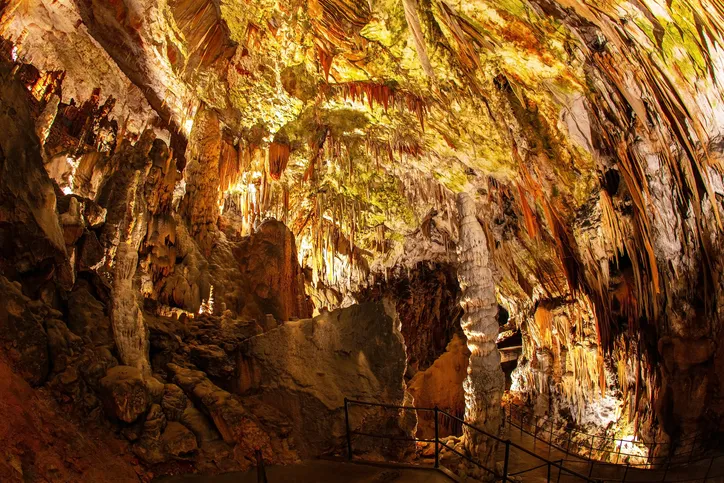Stanislav, our guide to Postojna Cave, reassures us: “I'll only turn the lights off for a minute or so.” Still, it’s a shock when we are plunged into pitch-black. My eyes strain to pick up even the faintest hint of light, but there is none.
We were warned it might be a bit overwhelming, and I’m starting to feel a little disorientated. The only thing I can hear is the quiet breathing of those with me, and the only thing I can feel is the cool metal rail that I’m gripping to steady myself.
I feel completely inadequate in terms of being adapted for the dark, and it’s bizarre to think that anything could live in this kind of environment, but Stanislav assures me that there are over 100 species found in this cave system, including a ‘dragon’.

Dragons of the deep
Postojna Cave is world-famous and is located in Slovenian’s karst region – a limestone plateau that stretches from southwest Slovenia to northeast Italy. The cave was carved by the Pivka River across millions of years, and many parts of the cave system are still flooded.
Graffiti dating to 1213 shows that the caves have been used by humans for centuries. The system is over 24km long, with at least four caves, connected by the river, and home to a variety of breathtaking rock formations, and to the secretive ‘dragons’.
- Weirdest fish: 12 of the strangest fish in the world
- 15 weirdest animals: meet the weird freaks and oddballs of the natural world
- 10 Ice Age animals: meet the extraordinary beasts that thrived when the world was frozen
But forget about any images you might have of fire-breathing beasts. The ‘dragons’ in question are actually olms, cave-dwelling salamanders, which have been surrounded by mystery for centuries. Local people often saw the olms after heavy rains washed them from the caves, and believed they were the offspring of 'cave dragons'. With the olm's sinuous body and external gills, it’s not too difficult to understand this particular case of mistaken identity.

The 'human fish'
Unlike the majority of amphibians, the olm is completely aquatic, and like all troglobites (true cave-dwelling creatures), it is adapted to living its whole life in the darkness of caves. It lacks any pigmentation in its skin, resulting in it being a pink or yellow-white colour. This led to it being described as a ‘human fish’ by locals, due to the similarity of its coloration to their own skin colour.
Skin pigmentation isn’t the only thing the olm lacks. Its eyes are severely undeveloped and, in fact, after a few months ofdevelopment during its larval stage, its eyes begin to atrophy (wither away). It does retain a small amount of photosensitivity, but why bother growing eyes at all if they aren’t going to be used for subterranean hunting? Instead, priority is given to its other senses.
"The ‘dragons’ in question are actually olms, cave-dwelling salamanders, which have been surrounded by mystery for centuries."
Caves predators
The olm has enhanced mechanosensory and chemosensory abilities. “Hearing is essentially mechanosensory – picking up vibrations or sounds caused by the motion of prey,” says Professor Geoff Boxshall, a zoologist at the Natural History Museum in London. “Similarly, for chemosensory abilities – it would be important for a scavenger locating decaying bodies, as there would be a good source of chemicals diffusing out of them, and the scavenger could home in on that.”
However, the olm also has an extra sense – the remarkable ability to sense the bioelectric field of other organisms. “All animals produce a weak bioelectric field from nerve impulses, muscle contractions, and so on,” continues Boxshall. “The olm is able to sense when its own bioelectric field is disturbed by an interaction with the field of an approaching creature, such as a shrimp, and can then catch its prey.”

Caves are low-energy systems, with no light and thus no plants nor photosynthesis. Cave food-webs are reliant on nutrients flowing into the cave from outside. The unreliability of such systems means that patience is the key for a cave’s residents.
The olm is an ambush predator, lurking silently and completely still, waiting for some unknowing creature to enter its bioelectric field.
During times of plenty, the olm is able to consume considerable amounts of prey and lay down reserves in its liver, to tide it over when food is scarce. Research has shown that, in extreme cases, olms can survive for a decade without feeding. If food is scarce, an olm will reduce its activity and lower its metabolic rate. In severe cases, it can even reabsorb its own tissue for nutrients.
"The olm is an ambush predator, lurking silently and completely still, waiting for some unknowing creature to enter its bioelectric field."
The olm develops relatively slowly and scientists don’t actually know how long it lives. One captive olm was recorded as being at least 58 years old, but there are some estimates that olms could live to be 100 – there's still much to be discovered about this elusive species.
- Is there really no such thing as a fish?
- Deadliest apex predators in the wild: which mammals are the best killing machines?
- Apex predators: What they are, why they're important and how apex predators affect ecosystems
Olm subspecies
The olm is renowned for being a pale creature lacking skin pigmentation. However, not all olms are the same. In fact, there is one recognised subspecies, Proteus anguinus parkelj, the black olm, which can be dark brown as well as black. Discovered in 1986, the black olm is restricted to an area smaller than 100sq km near Crnomelj in Slovenia.
The latest findings show that the olm has the extraordinary ability to regenerate lost limbs.
As well as having pigmentation, the black olm has a number of other differences to the nominate subspecies (P. a. anguinus). Its head is slightly shorter, with strong jaw muscles, and it has shorter legs. Though its body length is slightly longer (it has 34–35 vertebrae compared to 29–32 in the nominate subspecies), its tail is shorter, in proportion.
In addition, rather than having completely regressed eyes, the eyes of the black olm develop almost normally, and have principal rods, and both red-sensitive and blue-sensitive cones.

Postojna Cave life
Postojna Cave, and the surrounding cave system, is famous for the unusual number of species adapted to live in this ecosystem. Alongside the olm, there are over 100 other troglobites in Postojna, including spiders, pseudoscorpions and shrimp.
In fact, the first ever troglobite described by science – the slenderneck beetle or blind cave beetle, Leptodirus hochenwartii – was from Postojna. First discovered by cave lamplighter Luka Cec, the beetle was passed on to Count Franz Josef von Hochenwart – who was creating a guidebook to the caves – who passed it on to beetle expert Ferdinand Schmidt.
“It did not take long for Schmidt to realise this was a true troglobite,” explains Katja Dolenc Batagelj from Postojna Cave management. “The scientific circles were thrilled by the discovery and, because of the beetle and further discoveries, Postojna Cave became known as the cradle of a new science – speleobiology, the study of subterranean animals.”

New cave discoveries
The slenderneck beetle is referred to as the first troglobite to be labelled as such, because it was described in reference to its habitat. When olms were first scientifically described by Josephus Nicolaus Luarenti in 1768, the olms had been found outside of caves, when they had been washed out by high waters.
The slenderneck beetle also exhibits a number of adaptations for its cave-dwelling lifestyle. Like the olm, it has an extended lifespan compared to its surface-dwelling relatives and is also eyeless. It lacks any pigment, with its brown colour coming from the chitin in its exoskeleton. Its elongated antennae and tiny sensory hairs help it to move around the cave and, as it doesn’t need to fly, its elytra, or wing-cases, are fused together to create a dome, which allows it to regulate moisture.
Around the world, cave divers and scientists are continuing to discover new species. In 1981, after advances in cave scuba gear enabled divers to penetrate flooded caves in the Bahamas, Dr Jill Yager described a new class of crustaceans – the remipedes. Blind creatures thought to be more closely related to insects than any of the other crustaceans, remipedes inhabit coastal aquifers filled with saline groundwater and are named after their legs, with Remipedia derived from the Latin for ‘oar-footed’.
Yager and her colleagues were among the first to dive and explore the Lucayan Caverns, gradually adding to the maps with every dive. During these dives, Yager noticed small creatures in the water, including one that looked like marine polychaetes, a group of annelids known as bristle worms. Upon realising that it was a crustacean, she tried to identify it but without success. “I wrote letters, as there was no internet back in those days, and sent drawings to a few cave biologists but nobody could help,” she says. “Eventually, I realised that it had to be a new class of animals. It was really exciting for me to be able to describe these amazing animals. It was especially significant because I was ‘just’ a high school biology teacher at the time and I had my hands on the world’s most exciting crustacean!”
Alongside their adaptations for underwater cave life, remipedes have another unique feature, as Boxshall explains. “They are the world’s only venomous crustaceans. They hunt for shrimp through the water column in flooded caves and then kill using their venom-filled fangs. I think they are the most fascinating cave creatures.” To date, remipedes have been found in the Caribbean, Western Australia and the Canary Islands but, hidden away as they are, who knows where else they could be.
Further study
Scientists are still finding new, surprisingly large, troglobite species. Until recently, the olm was thought to be Europe’s only vertebrate troglobite. However, in August 2015, cave diver Joachim Kreiselmaier spotted and photographed cave fish during a dive in the Danube-Aach system in southern Germany. Between this initial sighting and 15 further dives until November 2016, Kreiselmaier and other divers were able to net and bring back five live loach specimens for scientists to study.
Like the olm, the cave loaches are adapted to their life in the dark. Compared to their surface-dwelling relatives, they have very pale skin which lacks scales, and they have reduced eyes.
Since the discovery of the cave loach, researchers have been studying it closely and have managed to breed it in captivity and sequence its genome.
Keeping troglobites in captivity provides scientists with the perfect opportunity to study these fascinating creatures and new, surprising discoveries continue to come to light through this research. In fact, recent findings from Postojna Cave show that the olm has the extraordinary ability to regenerate lost limbs.
As I leave the caves behind and emerge back into the daylight, I find myself thinking of the wide range of creatures that call the caves home, and I start to wonder what will be discovered next.
Feature first published in the December 2018 issue of BBC Wildlife Magazine.
Megan Shersby visited Postojna Caves with the Slovenian Tourist Board: www.slovenia.info
